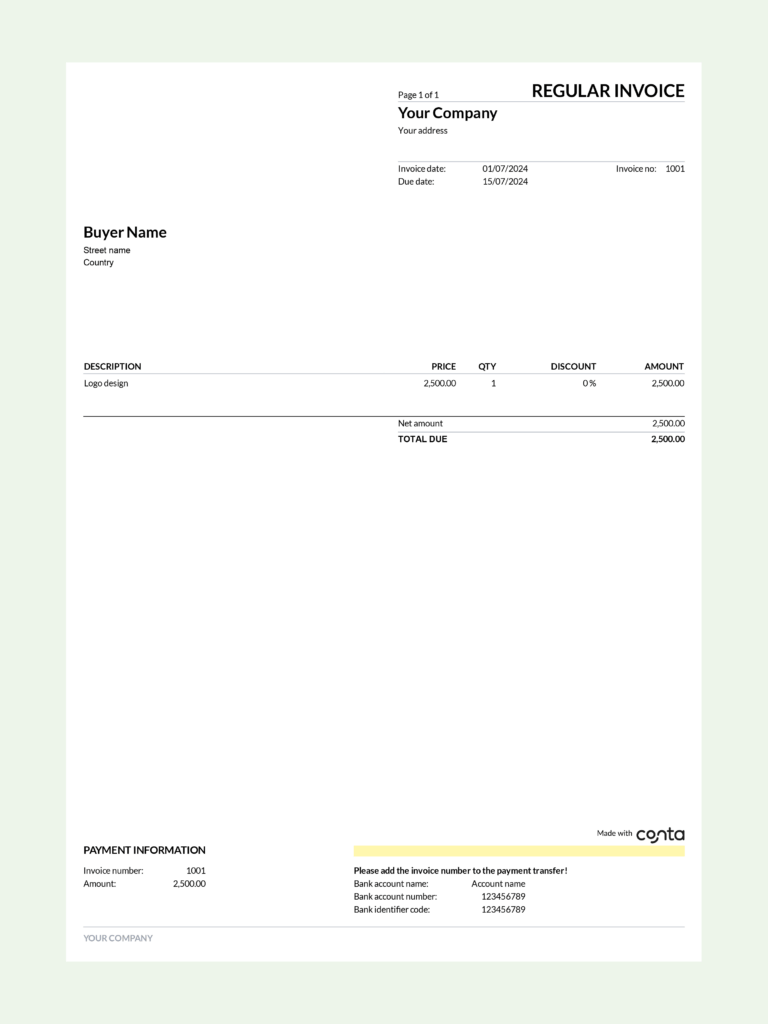As a freelancer, getting paid can be a hassle. In this guide, we’ll explain how you can easily create an invoice for freelance work that helps you get paid on time.
Regardless of what kind of freelance work you do, it’s essential that you get paid. In most cases, to get paid you have to send your clients an invoice.
We’ll give you a solid introduction on how to invoice for freelance work, including how to create an invoice, step-by-step.

How to create an invoice for freelance work
As a freelancer, you have a few different options for creating an invoice for freelance work, each with its own pros and cons. These are the most popular alternatives:
Make your own invoice template
Many freelancers create their own invoice template in Google Docs, Microsoft Excel or Word. When creating a template, you can tailor your invoice to your needs and you can tweak the design to match your brand.
The main downside of this method is that it can be very time-consuming. First of all, you have to take the time to set up the template, making sure to include all the necessary information. Each time you make an invoice, you have to manually fill in the details—and calculate the sums, if you’re working in Word or Google Docs. Then you have to export as PDF and send to your clients, for example via email. You have to store all your invoices somewhere safe, and then go through them manually to check which ones are paid, overdue and so on.
Use an existing invoice template
Another alternative, is to download a free invoice template that you can use to create and send professional invoices. You can download the templates in a variety of formats, such as Excel, Word, Google Docs and Google Sheets, and customize them to your needs quickly and easily.
There are, however, some downsides to using templates. The main downside is that invoice templates don’t assign invoice numbers automatically, which is a legal requirement in some markets. It can also be a hassle to follow up on your invoices when you have them all in Excel or Word. This is how to use a freelancer invoice template.
What is an invoice number?
In order for an invoice to be valid, it has to have a unique invoice number. The first time you create an invoice, you can start with any number you want, but proceeding invoices have to numbered in ascending order. For example, if you start with 1001, the next invoice should be 1002, then 1003 and so on.
When you use an invoice template, these numbers are not automatically added, but can either be entered in the wrong order—which causes mistakes in your bookkeeping—or, some people can even choose to manipulate these numbers to disguise pat of their income. That’s why in many countries, you have to use either pre-numbered invoice pads or invoice software, which assigns numbers automatically.
Use an invoice generator
With an invoice generator, you can make invoices in your browser, for free. It’s quick and easy, just fill out the fields and click to download a PDF invoice. However, you have to manually fill out the fields each time, and your invoices aren’t stored anywhere.
We’ve tested the best free invoice generators.
Try invoicing software to invoice for freelance work
With cloud-based invoicing software, such as our free invoicing software for freelancers, you can create, send, and track invoices in your browser or using the free mobile app for iOS or Android. Most softwares are easy to use, with smart features such as recurring billing and automatic payment reminders. Another benefit of invoicing software is that all your invoices are safely stored, and you can easily see which invoices you need to follow up on.
A downside, however, is that invoice softwares can be costly. That’s why you should look into free invoicing software.
Freelancer and ready to send your first invoice?
Get started with free invoicingSee also: 6 best invoicing software for freelancers
Pro-tip: Work out your rate with the hourly rate calculator
The freelance hourly rate calculator makes it easy to determine the minimum amount you should charge. Just enter your ideal take-home pay after tax, enter how days you’ll be working per year, your tax rate, and an estimate of your costs. The calculator will tell you how much you should be charging per hour.
You can also check out our article about how to set your hourly rate as a freelancer.
5 things you should include when you invoice for freelance work
To ensure quick and correct payment, your invoice for freelance work should include all the relevant information. Make sure to include:
1. Contact details
Ensure that the invoice clearly identifies the parties involved by including the following information:
- Your name and brand name, if revelant
- Your address
- Your phone number and email
- The client’s name or the company name
- The client’s address
- The clients phone number and email
2. Invoice number
All invoices should have a unique invoice number for accounting and tax purposes. In many countries, a unique invoice number is a legal requirement
If you use invoicing software, the invoice number is added automatically. Otherwise, you have to choose a number to start off, for example 1 or 1001, and then increase the number on each subsequent invoice or credit note.
3. An itemized list of goods and services
Clearly state what the client is paying for with a detailed list of goods or services, along with the quantity and price of each item, as well as tax and discounts, if applicable.
4. Payment terms
Explain how you want the client to pay you and when the payment is due. Also remember to mention other payment terms, such as late payment fees that will be added if the client doesn’t pay on time.
We’ve answered all your questions about payment terms.
5. Total amount due
It’s important to include the total cost of the products or services, along with any applicable taxes or discounts.

What’s the best way to send an invoice for freelance work?
The most popular and the quickest method of sending an invoice is via email. You can send it directly from Conta or download the invoice as a PDF and attach it in an email. You can also print out the invoice and send it in the mail, but this takes longer. See how to send an invoice.
With invoicing software, invoices and payment reminders can be sent directly from the system. Alternatively, you can use this email template when you invoice for freelance work:
Subject: Invoice for services rendered – [invoice date]
Dear [client],
Attached you’ll find the invoice for services that were provided to you on [date].
The total amount due is [amount]. The invoice includes a breakdown of the services, the hours worked, as well as the hourly rate.
If you have any queries, please let me know; I would be happy to address any issues.
Thank you for doing business with me, I look forward to continue working with you in the future.
Sincerely,
[Your name]
[Your brand name]
Useful tips when clients don’t pay on time
As a freelancer, it’s important to ensure you earn a sufficient amount of money, while also maintaining good client relationships. When a client fails to pay on time, that balancing act can be daunting.
However, there are some steps you can take to reduce the risk of customers paying late, and to handle the situation in a professional manner if it does happen.
One way to reduce the risk is to clearly communicate your payment terms and expectations before starting the work, in the form of a contract which lists the total cost, the payment schedule, and consequences for late payments.
If a client doesn’t pay on time, it’s important to follow up quickly via email or phone. If the client is unable or unwilling to pay, you can consider offering a payment plan, hiring a collections agency to assist you, or taking legal action.
See also: How to earn more as a freelancer
Pro-tip: Manage your outstanding invoices for free
Conta’s free invoicing software gives you an overview of overdue invoices. It’s easy to keep track of your finances and follow up with your client. Create, send, and manage your invoices all in one place.





